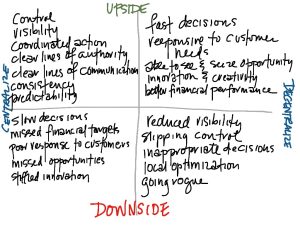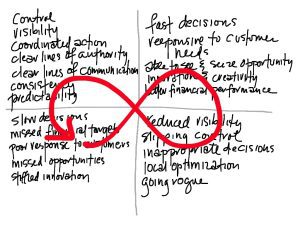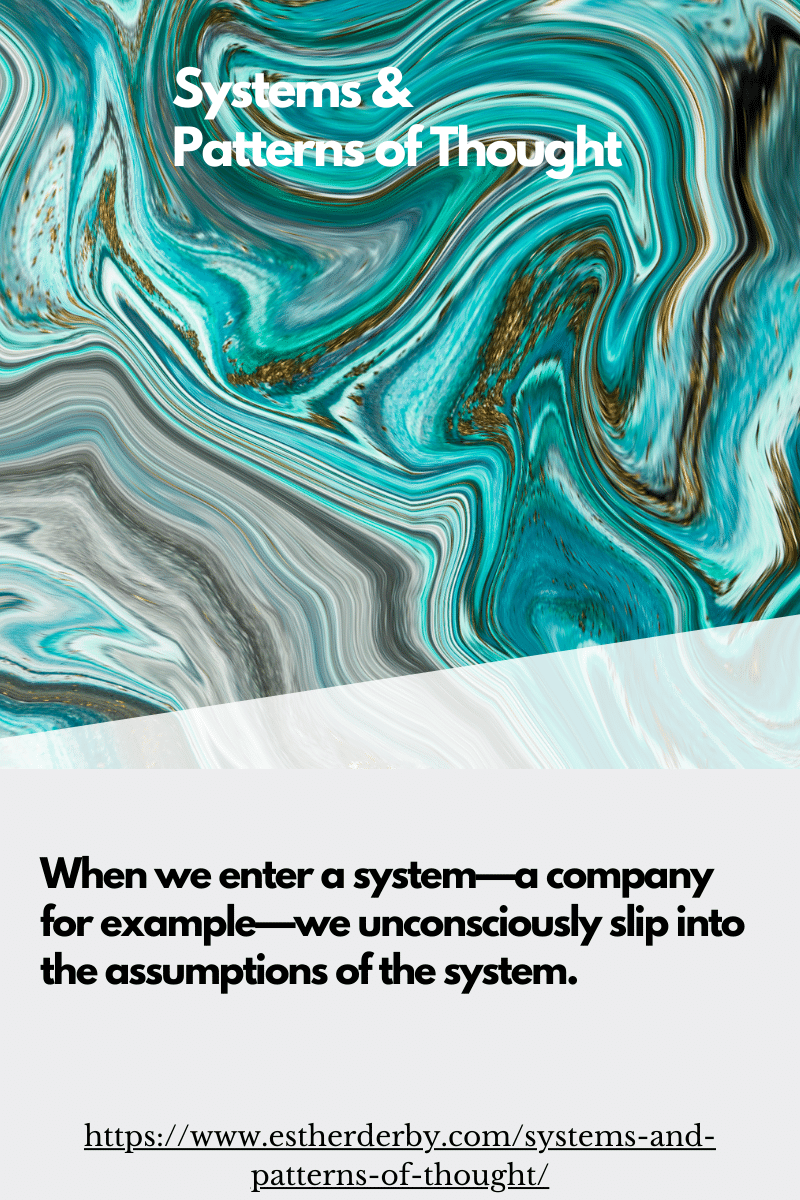Leaders take action to solve problem in their organizations. They might send out a directive, announce a new policy, or re-organize the department. But, every solutions has the seed for another set of problems. When those problems show up, they reverse course. Policy swings, just like a pendulum. Of course, over time, a new set of problems emerge with the new policy. So that’s cancelled, too. The replacement is often the opposite.
I’ve seen this pattern with vacation policies, work-from-home policies, decision-making, budgeting processes. To the people affected by these policies, it feels like whiplash. But from a distance, it looks like a classic oscillating system.
So let’s look at how the pattern plays out. I’ll choose an example I’ve seen many times: Centralized vs. de-centralized decision-making.
Action to Correct a Problem
In our example company, as in many companies, decisions have to go up the chain. That includes spending decisions, project variances, hiring decisions, approvals, and more. All of this takes time. It can take months to hire someone. Project variance committees meet monthly, and may not take up a request for several cycles.
Slow decisions lead to delays. Delays impact customer satisfaction and financial performance. As local discretion decreases, so does creativity. People lose their sense of ownership and engagement. It takes so long to change plans that the business misses opportunities.
Senior management notices. They want what most leaders want:
- faster decisions
- front-line people who are responsive to customers
- creativity & innovation
- the ability to adjust to seize new opportunities
- the ability respond nimbly to change
- financial results
Who wouldn’t want all those things? So they decentralize decision-making.
System Response
Things start happening faster! But they’re not always sure exactly what is happening. Visibility decreases. Decision making and spending feel out of control. Some managers make inappropriate decisions. Other optimize their department’s performance, forgetting the overall goal of the organization. Some managers strike out in directions that make no sense for the overall company strategy. Financial results dip.
The leaders want a return to clear lines of communication and authority. They want:
- visibility
- coordinated action
- predictability
- consistency
Who wouldn’t want those things? So they pull decision-making back to the center.
Sooner or later, the downsides of centralized control re-emerge. So, they decentralize.
Their solutions swing from one extreme to the other. Tight central control OR distributed decision-making. Meanwhile, the organization and the people in it experience an oscillating effect.
In most cases don’t want either extreme. They want the upside of both centralized control and local control. They want enough control to effectively coordinate. And they want enough autonomy so that all parts of the system can flourish and respond to opportunities and change.

Oscillating Systems
Why do systems oscillate? Delayed feedback and an over-vigorous correction. This happens on the organizational level. However, it can also happen on a smaller scale anywhere in the system where feedback is slow. Especially when well-intentioned people over-correct when they do get feedback on system performance.
An effective hierarchy provides enough central control for coordinated action. At the same time, there must be enough autonomy for subsystems to function and flourish. Too much control and the subsystem can’t respond well to novel situations. On the other hand, too little control leads to flailing. People may work at cross purposes. Or make decisions contrary to larger organizational goals.
In order to achieve the upsides, organizations need to manage the downsides. However, that requires faster and more robust feedback. Feedback loops and steering signals provide information about system behavior. Which allows smaller more nuanced adjustments. And that prevents oscillation.








The pendulum dynamic can also have a value in itself.
In centralised mode, we focus on what’s important across the entire organisation. In decentralised mode, we focus on how local variations matter. If we pay attention across the entire loop, we learn about both sides of the picture.
If we get stuck in any one place (either end of the pole or some “balance point” somewhere in the middle of it), it becomes harder to explore and learn about all these different perspectives and how they’re changing over time & in response to the wider environment.
Problem is, most organisations don’t manage the swing as a dynamic learning experience. They treat it as a search for some mythical perfection point.
Yes, there’s a lot to learn /if/ you view the organization as a dynamic system that is always in process.
In the best scenario, yes, this can be a “dynamic learning experience”, but we rarely live in Utopia. In the real world, the change from one state to another is abrupt, wrenching, poorly planned and communicated. I’d like to see the transitions actively acknowledged as a process.
Esther,
Has anyone done research on the correlation between oscillation and long-term company success?
Cheers, Ian
Hi, Ian.
Not that I know of…but it would be an interesting topic. I can’t imagine that it helps to lurch from one pole to the other. You’ve given me another thread to pull today 🙂
e
Ian see Larry Greiner’s “Evolution and Revolution as Organizations Grow” https://hbr.org/1998/05/evolution-and-revolution-as-organizations-grow
I would be really interested to know if anyone has any tips on how to manage resources when times get tough and help our leaders get through those periods without opting for the easier option of centralising – not just removing waste and process improvement (that’s a given). I would really like to understand what a blended best of
Both world approach looks like. Thanks